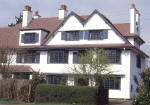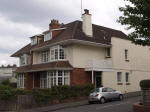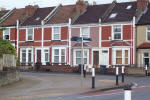|
|
7 Late Victorian and Edwardian Architecture - Change
|
Gradually, a reaction set in to the mixed classical and Gothic styles of
mid-Victorian architecture and to the artificiality – and perceived ugliness -
of machine made building parts and fittings. The result was the emergence of the
Arts and Crafts Movement which created a new aesthetic approach in all fields of
design based on a search for greater ‘truthfulness’ and simplicity in design. In
domestic architecture it led to the rise of a new style frequently referred to
as the ‘Old English Revival’. This can be traced to the building of the Red
House at Bexley Heath, Kent, designed by Philip Webb (1831-1915) for William
Morris in 1859. Rejecting machine made decoration, Morris and his circle of
friends made some of the fittings - including the stained glass and tiles -
themselves. The house was built of red brick with a high pitched, red tiled roof
and incorporated such romantic features as a turret, oriel windows and gables.
It marked a return to the vernacular tradition of building and became, in the
words of John Cloag, ‘the progenitor of a new school of domestic architecture’.
Much imitated, it became a dominant influence on the so-called ‘stock broker
belt’ housing – large detached houses built mainly in southern commuter villages
like Gerrards Cross, Buckinghamshire up to 1939. |
|
In the 1890s, a new interpretation of the Old English Revival emerged
through the work of C.F.A.
Voysey (1857-1941) and Sir Edwin Lutyens (1869-1944). In some of his country
houses, Lutyens combined classical style with the use of local materials as at
Heathcote, Yorkshire. The houses of Voysey and his followers built in the early
1900s for wealthy clients struck a modern look with their low ceilinged rooms,
horizontal windows, roofs sweeping almost down to ground level and white rough
cast or pebble dash walls, although Voysey always saw himself as an architect
working firmly within the traditions of English vernacular architecture; his use
of pebble dash, for example, came from the traditional harling of Scotland and
Cumbria. The photo on the right shows The White House by Dare Bryan after C. F.
A. Voysey, Leigh Woods, N. Somerset, 1901. |
 |
|
Another widely found late Victorian style is generally known as the Queen Anne
Revival. It was developed by the architects, W. Eden Nesfield (1835-1888) and J.
J. Stevenson (1831-1908), in the late 1860s although it is more usually
associated with the building of Bedford Park, Chiswick by R. Norman Shaw
(1831-1912) between 1875 and 1881. The style also borrowed details, such as tile
hanging, from vernacular architectural traditions but it also marked a return to
more symmetrical classical compositions using English and Dutch Renaissance
details and the use of red brick relieved by white painted woodwork. With its
winding tree lined roads, Bedford Park has been hailed as the first garden
suburb. The houses were individually built and incorporated a number of
important technological developments which emerged after 1870. Chief amongst
these was the introduction of improved sanitary arrangements including properly
trapped and ventilated house drains and the inclusion of a bathroom in the first
floor plan. Another departure from long established conventions was the
abandonment of the basement service wing in favour of a kitchen located on the
ground floor. |
|
From the 1880s through to the early 1900s, Shaw’s work was much imitated by
speculative builders for middle class housing and large, fussy, red brick houses
with porches, wooden verandas, small window panes in the upper sashes - and the
occasional Dutch gable - became a familiar part of the outer suburbs of London
and other large towns and cities. Stained glass became popular for front doors
and porches while the floor and dados of porches and hallways were often
finished in decorative tiles which were produced in huge quantities from the
1870s. After 1905, pargetting – decorative relief plasterwork - recalling the
seventeenth century domestic architecture of Essex and Suffolk – pebble dash
and half timbered gables became popular. In the hands of speculative
builders, suburban villas began to look like enlarged cottages. Although
roofs were prominent, houses were generally not as tall and there was now a
greater horizontal look to the facade. Plans tended to be squarer and
without a basement the main living rooms now had direct access to the
garden. |
 |
|
Some of these features found their way down to the better quality artisan
terraced house built around 1900. Often with their own name in imitation of
the larger house, these were villas within a terrace; they provided homes
for the upwardly mobile artisan and clerk – like the fictitious Mr Pooter of ‘The Laurels’, Holloway,
London. Terraced houses of between four and six rooms remained the answer for
mass urban housing. Typically laid out in straight, monotonous streets with
little open space and erected by small builders employing local methods and
material they still exhibited considerable local and regional variety. From the
1870s, national and local legislation aimed at improving public health at least
ensured that basic standards of construction, sanitation and adequate space –
front and back - were maintained. |
 |
|
|





